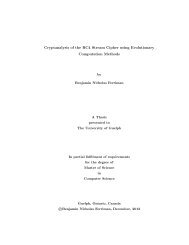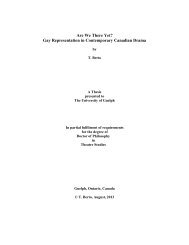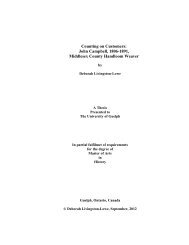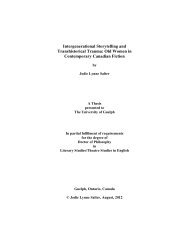THESIS - ROC CH ... - FINAL - resubmission.pdf - University of Guelph
THESIS - ROC CH ... - FINAL - resubmission.pdf - University of Guelph
THESIS - ROC CH ... - FINAL - resubmission.pdf - University of Guelph
You also want an ePaper? Increase the reach of your titles
YUMPU automatically turns print PDFs into web optimized ePapers that Google loves.
(21 nm) particle was seen to have a max TS lower than that <strong>of</strong> the smaller P90 (14 nm). With a<br />
larger particle size, the situation <strong>of</strong> the particle to an ideal bonding site where protein-protein<br />
interaction is not present may be more difficult. More importantly, the smaller surface area <strong>of</strong> the<br />
larger particle limits interaction opportunities thereby limiting the number <strong>of</strong> bonds present.<br />
These results elucidate the importance <strong>of</strong> the size <strong>of</strong> the nanoparticle. The smaller nanoparticle<br />
<strong>of</strong> P90 at 14 nm clearly yielded better mechanical performance with a lower optimal<br />
concentration compared to P25. Further research could investigate the optimization between<br />
particle size and concentration <strong>of</strong> nano fillers.<br />
7.4.2 MICROSCOPY OF TIO2/CELLULOSE/SPI BLEND FILM<br />
Light microscopy <strong>of</strong> SPI film incorporated with cellulose and/or TiO 2 is shown in Figure<br />
7.6. Each row represents a different treatment with each column from left to right representing<br />
the increasing concentration <strong>of</strong> additives. Looking to the SPI/TiO2 blend films in the first row,<br />
concentration effects <strong>of</strong> TiO2 were not apparent. The visible appearance <strong>of</strong> small particles<br />
scattered throughout these films are comparable to the SPI control film seen in Figure 6.4 from<br />
Section 6.4.2. Also similar, were the SPI/cellulose blend films where fibers have a large size<br />
distribution and with increasing concentration, the density <strong>of</strong> fibers also increased. The<br />
presence <strong>of</strong> TiO2 also yielded similar results with no significant differences compared to<br />
SPI/cellulose blends without TiO2 addition.<br />
99

















